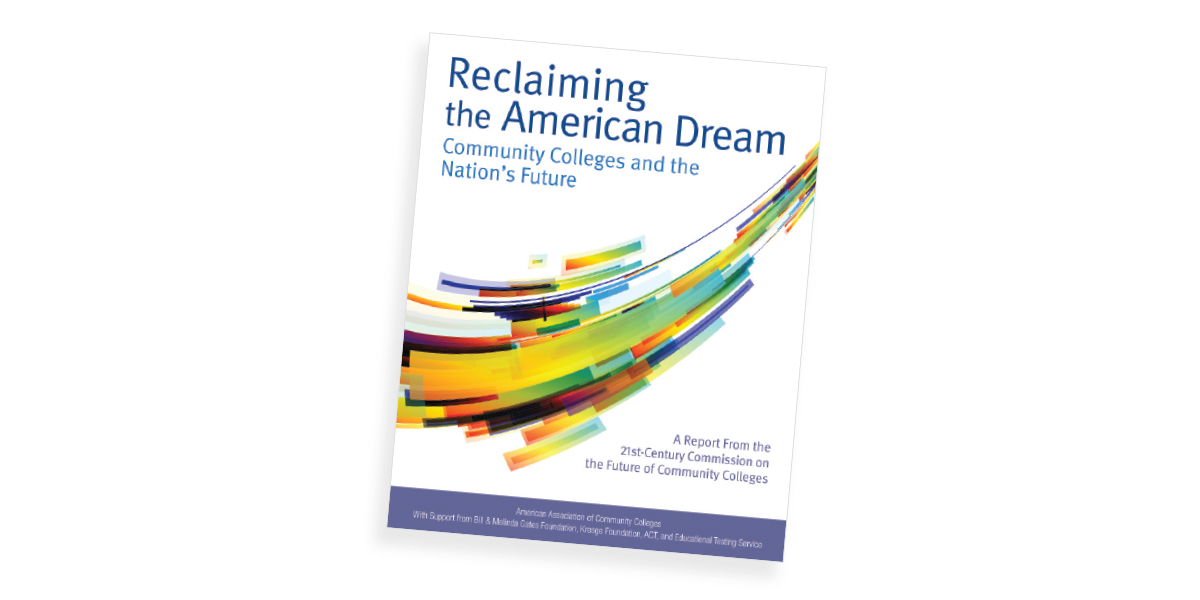When you examine the inherent business case for U.S. higher education today, it’s unlikely that any savvy Wall Street investor would view the enterprise as offering a promising return on investment.
Consider the salient indicators. Many employers—the clients for our “product”— point to a mismatch between the skills our students acquire and what the market needs to keep our workforce globally competitive. In the face of a more than 4 percent rise in tuition costs across the board during the past year, and tens of billions of public dollars spent in direct support of higher education annually, policy makers increasingly question the college value proposition.
For students themselves, the learning and achievement gaps among populations that demographers say will comprise the majority of future workers are disturbingly wide and persistent. Finally, the lack of alignment of learning pathways—from secondary to postsecondary to the workplace—leads far too many entering students into a morass of developmental coursework, and results in a college attainment rate among younger students that ranks the United States at an embarrassing 12th in the world.
Meanwhile, our real and primary investors—state, local, and federal governments—continue a marked disinvestment in higher education, as declining revenues and more pressing needs have pushed postsecondary education lower in the financial food chain. According to the Delta Cost Project, state and local appropriations for postsecondary education in 2010 declined between 9 percent and 15 percent, with community colleges taking the hardest hit and having far fewer options to make up lost revenue.
Forecasters don’t expect those dollars to rebound anytime soon. That painful reality leads us as educators to the inescapable acknowledgment that our business model demands recalibration. Failing that, we will increasingly operate on what a recent Pew Research Center report termed the “cusp of irrelevance.”
Early in my career as a dean of student services and vice president, I was responsible for some functions that are typically in the business officer’s portfolio, gaining firsthand experience with a job that has since become increasingly complex. Over the more than three decades that followed, I have worked with a number of outstanding business officers as I moved from CEO of two community colleges, to a state system, and now to president of a national association.
From this vantage point, I can state with some understanding that the role of the campus business officer has never been more challenging or more vital. As we stare down the need to reinvent our business model, reorder priorities, and redirect resources, we face a steep operational climb. And yet, I have never been more excited about the opportunities this brings for a true renaissance of the academic enterprise.
Rising to the Occasion
The need to reimagine academic priorities and possibilities is especially critical for this country’s community colleges, which educate close to half of all U.S. undergraduates, provide the bulk of workforce training, and thus are central to any national solution. The community college sector operates closer to the financial margins than does any other sector, and it has been hard-hit by years of rising enrollments coupled with near draconian budget cuts. A report from the National Student Clearinghouse reflects declining enrollments of 3.6 percent at community colleges for spring 2013.
However, pent-up demand persists, particularly in key programs such as allied health and IT, and in states like California, where budget shortfalls have reduced capacity and resulted in thousands of students being unable to enroll. These institutions understand better than most the urgent need to revise the business model, and they must do so while fiercely protecting their open access mission. In substantive ways, community colleges are akin to the canary in the coal mine, stepping into uncharted territory with pitfalls all around.
Leading the reinvention of the community college has been the primary thrust of my early tenure as president and CEO of the American Association of Community Colleges (AACC). The appointment in 2011 of the 21st-Century Commission on the Future of Community Colleges—a 38-member blue-ribbon panel of educators, philanthropists, and business and organizational leaders—was the first major step in what will be an ongoing reincarnation.
The commission’s 18-month examination of challenges and opportunities facing community colleges culminated in a groundbreaking report, “Reclaiming the American Dream: Community Colleges and the Nation’s Future.” This report was brutally honest about the accomplishments and failings of our nation’s two-year colleges. The publication and dissemination of the report have been followed by an implementation phase still under way that will result in 2014 in the completion of a community college blueprint for strategic action within the next decade.
Given the enormity of the challenges facing higher education writ large, the commission urged community colleges to concentrate their efforts on three key priorities: (1) redesigning students’ educational experiences, (2) reinventing institutional roles, and (3) resetting the educational system. Although the commission’s focus was community-college‒specific, these three Rs comprise challenges shared by many, if not most, postsecondary institutions.
Redesign Educational Experiences
Among the more frustrating issues affecting student performance is the fact that solid research exists to underscore strategies that work but that are not being utilized. For example, the Community College Survey of Student Engagement (CCSSE) and other research have demonstrated the importance of mandatory orientation and early advisement for entering students. Yet, almost a third of community college students do not attend any type of orientation, in person or online, and a majority do not seek advising assistance in setting academic goals or developing a plan for achieving them.
Many community colleges are characterized by a similar lack of clearly delineated and integrated pathways that lead seamlessly to completion. As director of the center that administers CCSSE, Kay McClenney pointed out in a recently penned article for Community College Journal that “[I]nstead of an integrated and coherent experience, students encounter each aspect of the college in isolation.” Inexperienced in navigating the vagaries of academe and faced with an array of options, many students make poor choices or no decisions at all, either of which can contribute to lost effort, wasted time and money, and far too often, academic failure.
The business officer can improve this process in multiple ways. By helping to configure the availability of essential services as a contiguous, one-stop shop—increasingly common on our campuses—operational leaders help students avoid the confusion and frustration of having to trek from registration to financial aid to counselors, and so on. By ensuring 24/7 online access to information and services, and deploying the most current technologies, we meet students where they learn, providing mobility and flexibility.
Reinvent Institutional Roles
A massive turnover in community college leaders lurks over the academic horizon, and it includes those individuals tasked with managing operational and financial services. From the CEO to the CBO to the CTO to the CIO, professional educators will be retiring en masse in the coming years. Recent research compiled by AACC indicates that up to 75 percent of sitting community college presidents will retire within the next decade, and other senior leaders are not far behind. This huge exodus from the C-suite brings unprecedented opportunity to transform our institutional roles.
Such extensive change will require a commitment to professional development across the institution, an exigency that business officers should be prepared to support with resources and through infrastructure redesign. It will also require leveraging technology to expand learning and control costs.
College business officers will likely play a role in evaluating the advisability of instituting MOOCs [massive open online courses], determining the investment needed to ramp up online delivery, calculating pricing for hybrid programs, and myriad other decisions. They may also find themselves taking the lead in evaluating new vendors and services, and deciding on cost-saving measures such as downsizing, or outsourcing key functions such as campus security and food services.
Most importantly, the business officer must lead in developing and promoting data systems that track results across the institution to allow informed decision making. Especially for community colleges—with their broad missions and diverse education and training needs—there exists the painful need to eliminate programs and practices that squander precious resources in ways that do not produce demonstrable and positive outcomes for students.
As enrollments flatline or decline, public funding stagnates, and calls for tuition caps grow increasingly insistent, hard and unpopular choices must be made. As a foundation for ongoing, informed, and positive dialogue, business officers can help the diverse campus family understand how and why resources are allocated, and what they can expect related to their own piece of the budget pie.
Reset the Educational System
Increasingly, employers and others seek assurance that credentials represent real, consistent, and measurable knowledge and skills and provide career pathways that ensure upward mobility. The need to reboot skill sets for adult learners, and the return of thousands of military service members whose on-the-job training must be translated into academic-ese, give impetus to a need for greater and more coherent systems of awarding credit for prior learning. Clearly, the systems that have served the nation well for decades must undergo vast and even radical transformation if our nation is to thrive and compete in a world economy.
Likewise, a recovering economy, scarce resources, and a plethora of needs contribute to a rising and urgent demand for proof that public dollars invested in higher education deliver expected returns. Both state and federal policy makers are calling for greater accountability and transparency. Particularly in today’s funding environment, it is critical that those responsible for cost containment and budgeting have a seat and a voice at many tables, not only within the president’s cabinet or among members of the institution’s governing board.
It is equally important that the financial team become adept at explaining budgeting and financial strategies in clear, contextual, and nontechnical terms that help build esprit and cooperation internally. The messaging must be equally clear and positive with external audiences such as voters, legislators, and the news media. To assume that the numbers speak for themselves would be misguided at best.
Leaning Forward
While the AACC community awaits insights and direction from the implementation teams tasked with developing specific and strategic actions we must take with regard to these three Rs, we know this: If we want to achieve the degree and credential completion agenda we need as a nation to compete globally, the higher education system across the board must undergo transformation. This reinvention must be comprehensive—from how we prepare students, to how we teach them, to how we support their success and assess their proficiency. A big part of this entails driving innovation into the curriculum. For community colleges, this requires special attention. For instance, we must:
- Focus career and technical education on preparing students with the knowledge and skills required for existing and future jobs in regional and global economies.
- Redesign our curriculum in a way that provides coherent career pathways and that stacks credentials into meaningful certificates and degrees, as students progress through their programs of study. These multilevel, industry-recognized credentials must reflect attainment of the knowledge and skills required at different stages of a career.
- Establish alternative models for completing skills-based credentials, including classroom instruction, online learning, credit for prior learning, and on-the-job learning.
- Expand the community college role as broker of educational access, connecting students to learning opportunities through multiple providers and modes of delivery.
- These are but a handful of the ways in which we must reinvent the community college curriculum, sooner rather than later. In the critical role that community colleges play as a bridge to higher learning and financial stability for millions of Americans, the success of the nation and the preservation of the middle class depend on our success as a sector.
WALTER G. BUMPHUS is president and CEO of the American Association of Community Colleges, Washington, D.C.




